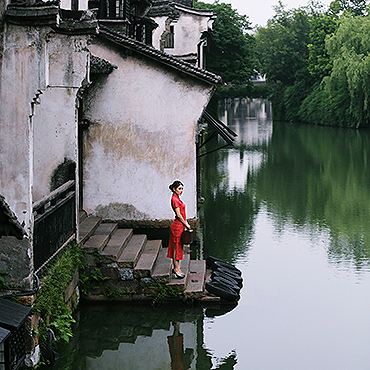
Chinese art offers a window into the long and fascinating history that is intrinsic to this country’s legacy. However, a deep study of art in China would take many years due to the many different art forms, historical periods, ethnic influences, and central themes.
Encompassing calligraphy, painting, sculpture, ceramics, literature, and poetry, art in China has endured over millennia, reflecting preeminent Chinese cultural values: a deep regard for nature; a belief in art’s purpose to educate and guide morally; and simplicity. Proficiency in brushwork, a presentation of different perspectives, and a dedication to subjects – such as lotus leaves, dragons, willows, and misty mountains – are all synonymous with Chinese visual art. And while artistic influence is drawn from its geographic neighbours, equally, the influence of Chinese art extended well beyond its borders to Korea, Japan, and Vietnam.
Chief among the various visual art forms were – and remain – calligraphy and painting. These were practised by amateurs, as well as professionals engaged by the Imperial court and very wealthy, with art reflecting class distinctions, in accordance with principles of Confucianism. A reverence for restraint and austerity so much a part of Chinese art for centuries, observers can see how these qualities pervade both the art and the artists who created it.
Read on to learn a little more about the fundamentals of art in China.
Symbols in Chinese art

Chinese art was characterized by very clear guidance around what did and did not constitute art. This guidance – or some would say a rigidity – around conventions was provided to artists and collectors, with the former expected to copy famous artworks in their training. The most important of these was considered to be “spirit resonance”, to be interpreted as vitality, according to Xie He, an art critic from the 6th century.
A deep appreciation for nature, life’s natural rhythms, the harmony found in the balance of yin and yang, are all found in classical Chinese artworks. You will not find art for art’s sake in China. Instead, art is deeply symbolic, spiritual, and in many ways, metaphorical.
| Bamboo | The scholar’s spirit |
| Jade | Purity and unable to be destroyed |
| Dragon or alligator | A compassionate emperor who could also be dangerous |
| Crane | Longevity |
| Paired mandarin ducks | Faithfulness in marriage |
| Orchid | Purity and loyalty |
| Winter plum | Unable to be restrained |
| Gnarled pine tree | Survival (in politics or old age) |
| Deer | Health and wealth |
| Fish | Fertility and abundance |
There are many more symbols woven into Chinese art, however, as you explore museums, galleries, and ancient buildings, undoubtedly you will find other symbolic representations that will help you understand both the artwork before you, and the history of China itself.
Calligraphy

Calligraphy is considered an art form in and of itself. From the earliest time when it first emerged during the Han dynasty (206 BCE – 220 BCE), calligraphers were held in the highest regard.
Any Chinese person will tell you, calligraphy is far more than writing. Its status as an art form comes from the exceptional skill required to maintain control of the brush and ink. Added complexity comes with a variety of scripts, including: seal (Zhuanshu); official (Lishu); running (Xingshu); cursive (Caoshu); and regular (Kaishu). The ‘poetry’ of calligraphy is also found in the names given to the tools used, namely the Four Treasures of the Study, which denote the brush pen (bi), ink stick (mo), paper (zhi), and inkstone (yan).
Beyond simple writing, calligraphy requires deftness and skill to enable the brush to form different types of strokes on subtle angles. Fluidity, precision, the use of space, and aesthetics are central tenets upon which calligraphy is created. Different scripts require different pen methods. When writing seal scripts, the brush movement should be soft and solemn; when writing cursive scripts, the brush movement should be smooth and powerful. The popularity of calligraphy grew such that it became a feature of paintings too, where it was used to describe the picture in the painting. Another trend saw artwork owners add their own seal in red ink to paintings, something which continues to today.
Calligraphy was written on silk, bamboo or wooden slips, paper, canvas, and plastered walls, while brushes were made from animal hair. Of course, the historical evolution of ink is fascinating in itself. During the Warring States period (770 – 221 B.C.), the ancient Chinese began using writing brushes and ink sticks (the tiny round piece, not the moulded block). During the Han dynasty, things had moved on, and ‘man-made’ ink sticks appeared, and in later dynasties, the technique and artistic skill associated with production of ink and ink sticks became quite developed. Artists or their attendants made the ink by rubbing the ink stick on the inkstone with a small amount of water. This was done as there was no commercial ink production, and while these techniques are not commonplace now, those with an appreciation and reverence for this the true principle of calligraphy continue to follow the ancient principles developed by the early artisans.
Chinese painting

Just as calligraphy is central to Chinese culture, Chinese painting enjoys a rich tradition too. The Five Dynasties and Song dynasty were considered the heyday of Chinese painting. In terms of ancient Chinese painting, landscapes (including flowers, birds, rocks, trees, and mountains) and portraits have long been the predominant themes. The Tang dynasty period saw landscapes really come into their own.
Consistent with Confucian principles, Chinese painting also reflected the restraint and conservatism evident in other Chinese art forms. Wonder why people portrayed in paintings show such little emotion? It was expected that only the slightest emotion would be shown in paintings; a sign of the artist’s morality.
Later paintings found in tombs included more ‘human’ elements with depictions of family scenes quite common. Folk paintings also appeared, such as the famous Along the River During the Qingming Festival , from the Northern Song dynasty period, which vividly depicts the prosperous scene of Bianjing city (now Kaifeng) in a long scroll composition. With such detail it is considered to faithfully show social life at the time of the painting.
Chinese Ceramics

In terms of ceramics, the Song Dynasty was considered the period during which this Chinese art form reached its pinnacle. Sophisticated kilns were established in northern and southern China. Among them, the most precious and famous were the five great kilns at Ru, Guan, Ge, Ding and Jun , from which even large export sales were achieved. High-end porcelain crafted during this period supplied the Imperial court. Ceramics from Longquan kilns and Jingdezhen were also mass-produced for export at this time. During the Yuan dynasty, Jingdezhen ceramics truly came into their own. The most famous porcelain from this period were the iconic blue and white porcelain and red glaze porcelain.
We’ve barely touched the surface of Chinese art in this article – there is just so much more to it. Time spent with an experienced and knowledgeable guide exploring significant sites and museums in destinations such as Beijing, Xi’an, and Shanghai , provides insights you won’t find in any book or blog. If this sounds like the kind of experience you’d love to enjoy while exploring China, now could be the perfect time to reach out to guides who would love to bring your travel dreams to life.
Traditional Chinese art is just one aspect of Chinese culture. If you’re keen to learn more, explore our China Travel Guide for more great information. Be travel ready and make the most of your time on a China culture tour. Our team of travel consultants can advise on enriching activities and experiences that will make for beautiful travel memories from your China vacation. Reach out – We are here to help!




 Beautiful China!
Beautiful China!





